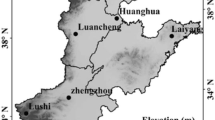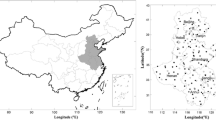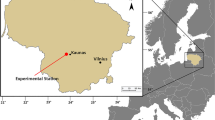Abstract
The evident climate jump after 2000 in China may have greatly influenced the production of winter wheat, which is one of the nation’s major grain crops. To evaluate the impacts of climate change on winter wheat production and identify the climatic factors primarily responsible, we used daily meteorological data from 2244 stations and integrated indicators to examine the decadal changes in the potential plantable zone (PPZ), growth periods, and climatic suitability for winter wheat in China from 1985 to 1999 and from 2000 to 2014. The results showed the following: (1) The PPZ has decreased by approximately 9%, and the main reason may be the increased frequency of extreme cold events in northern China from 2000 to 2014. (2) In most of the PPZ, the suitable sowing date has been delayed, the potential maturity date has advanced, and total days during the potential growing season have significantly decreased because of the increasing temperature. (3) The suitable area and optimal area of winter wheat have significantly decreased by 9% and 13%, respectively. The changes in climatic suitability are affected by both temperature and radiation in the north, whereas the impact is more from precipitation in the south. The climate may be changing in a direction unsuitable for winter wheat. As global warming and climate extremes intensify in the future, winter wheat production may become more challenging, and adequate measures should be adopted to guarantee reliable and high yields.








Similar content being viewed by others
References
Araya A, Coauthors (2010) A new agro-climatic classification for crop suitability zoning in northern semi-arid Ethiopia. Agric for Meteorol 150(7–8):1057–1064. https://doi.org/10.1016/j.agrformet.2010.04.003
Bebber D, Ramotowski M, Gurr S (2013) Crop pests and pathogens move polewards in a warming world. Nature Clim Change 3:985–988
Cai J, Dong J (2011) The effect of climate change on winter wheat production in China. Journal of Agro-Environment Science 10:109–119
Cao LJ, Coauthors (2016) Climatic warming in China according to a homogenized data set from 2419 stations. Int J Climatol 36:4384–4392
Chen RS, Coauthors (2014) Precipitation type estimation and validation in China. J Mt Sci 11(4):917–925. https://doi.org/10.1007/s11629-012-2625-x
Chen, S, 2020: The spatiotemporal shift of the northern limit of winter wheat in northern China and its influence mechanism. Chinese Academy of Agricultural Sciences Thesis.
Chen X, Coauthors (2019) High daytime and nighttime temperatures exert large and opposing impacts on winter wheat yield in China. Weather, Climate, and Society 11(4):777–790
Chu R, Shen S, LCoauthors H (2015) Characteristics of agricultural climate resources change in winter wheat region of the Huanghuai sea under the climate change scenario. Sci Tech ENG 15(26):1–10
Cohen J, Screen J, Furtado J et al (2014) Recent Arctic amplification and extreme mid-latitude weather. Nature Geosci 7:627–637. https://doi.org/10.1038/ngeo2234
Dai L, Li C, Yao S, Coauthors (2010) Analysis of winter wheat freezing damage in Hebei Province under the background of climate warming. Chin J Agrometeorol 31(03):467–471
DaiCoauthors L (2011) Climatic suitability of winter wheat and its spatial-temporal changes in Hebei Province. Chin J Agrometeorol 32(3):399–406
Deng H, Guo B, CaoCoauthors Y (2020) Spatio-temporal pattern of diurnal and diurnal precipitation changes in China from 1961 to 2016 Geogr. Res 39(10):1–13
Deng Z, Yin D, Zhang Y (2000) Study on the ecoclimatic suitable planting area of wheat in Gansu Province. Meteorol Sci Tech 1:36–40
Deng Z, Zhang Q, Qian J (2009) The influence of warm and dry climate on dry and hot wind in northern China. J Glaciol and Geocryology 4(31):664
Du Y, Coauthors (2020) Study on spatiotemporal variation characteristics of precipitation structure in China in recent 40 years. Water Power 46(08):19–23
Eric B, Coauthors (2020) Decoupling of impact factors reveals the response of German winter wheat yields to climatic changes. Glob Change Biol 26:3601–3626
Fan Z, Coauthors (2013) Effects of controlled release fertilizer on physiological characteristics of winter wheat in slope cultivated land. Phos. & Comp. Fert 28(04):83–85
Fang S, Coauhtors (2012) Fields experiments in North China show no decrease in winter wheat yields with night temperature increased by. C Sci China Earth Sciences 55(6):1021–1027
Feng S, Hu Q, Qian W (2004) Quality control of daily meteorological data in China, 1951–2000: a new dataset. Int J Climatol 24:853–870
Gao S, Guo J (1999) Countermeasures to improve the utilization rate of climate resources in the three north areas of China. Resour Sci 21(04):54–67
Gubler S, Coauthors (2017) The influence of station density on climate data homogenization. Int J Climatol 37:4670–4683
Hao Z, Zheng J, Tao X (2001) Study on the northern boundary of winter wheat planting in the context of climate warming: a case study of Liaoning Province. Prog Geogr 20(03):253–260
He L, Asseng S, Zhao G, Coauthors (2015) Impacts of recent climate warming, cultivar changes, and crop management on winter wheat phenology across the Loess Plateau of China Agric. For Meteorol 200:135–143
Heil, K and Coauthors, 2020: Influence of climate conditions on the temporal development of wheat yields in a long-term experiment in an area with Pleistocene Loess Climate, 8(9).
Heikkinen R, Leikola N, Aalto J, Coauthors (2020) Fine-grained climate velocities reveal vulnerability of protected areas to climate change. Sci Rep 10:1678
Hu S, Fedorov A (2017) The extreme El Niño of 2015–2016 and the end of global warming hiatus. Geophys Res Lett 44:3816–3824
Jurandir Z, Coauthors (2006) Impact assessment study of climate change on agricultural zoning. Meteorol Appl 13(S1):69–80
Kim H, Hyun S, Hoogenboom G, Coauthors (2018) Fuzzy union to assess climatic suitability of annual ryegrass (Lolium multiflorum), alfalfa (Medicago sativa) and sorghum (Sorghum bicolor). Sci Rep 8:1
Kong F, Coauthors (2017) Spatiotemporal differentiation of climate warming rates in different periods in China (1961–2014). J BNU (natural Science) 53(04):426–435
Li CY (2019) On possible mechanisms of interdecadal climate variability. Climatic and Environmental Research 24(1):1–21. https://doi.org/10.3878/j.issn.1006-9585.2018.18088
Li L, Zha Y (2019) Satellite-based regional warming hiatus in China and its implication. Sci Total Environ 648:1394–1402. https://doi.org/10.1016/j.scitotenv.2018.08.233
Li L, Zhang H, Chen F, Coauthors (2007) Carbon dioxide emission flux and its relationship with soil temperature in the growing season of winter wheat under different tillage measures. J Appl Ecol 12:2765–2770
Li Q, Coauthors (2015) China experiencing the recent warming hiatus. Geophys Res Lett 42:889–898. https://doi.org/10.1002/2014GL062773
Li YG, Coauthors (2014) Variability of extreme precipitation over Yunnan Province, China 1960–2012. Int J Climatol 35:245–258. https://doi.org/10.1002/joc.3977
Liang S, Li Y, Zhang X, Coauthors (2018) Response of crop yield and nitrogen use efficiency for wheat-maize cropping system to future climate change in northern China. Agric for Meteorol 262:310–321
Liu D, Dong A, Lu D (2005) Climate change in Northwest China in recent 43 years and its impact on agricultural production. Agric Res Arid Areas 23(02):195–201
Liu, J. 2009: Study on the estimation index of the production potential of winter wheat and corn in the Dryland of Longdong [D]. Gansu Agricultural University.
Liu Y, Chen Q, GeCoauthors Q (2018) Modelling the impacts of climate change and crop management on phenological trends of spring and winter wheat in China. Agric for Meteorol 248:518–526
Lopes M, Coauthors (2018) Optimizing winter wheat resilience to climate change in rain fed crop systems of Turkey and Iran. Front Plant Sci 9:563
Lv Z, Coauthors (2013) Climate change impacts on regional winter wheat production in main wheat production regions of China. Agric for Meteorol 171–172:234–248. https://doi.org/10.1016/j.agrformet.2012.12.008
Ma Q, He Y, Zhang M, Coauthors (2018) Response of wheat growth period to accumulated temperature change in growth stage in winter wheat region of northern China. Chin J Agrometeorol 39(04):233–244
Mauritsen T (2016) Clouds cooled the Earth. Nat Geosci 9(16):865–867
Mei X, Qiong F, MichaelCoauthors J (2014) Are droughts becoming more frequent or severe in China based on the Standardized Precipitation Evapotranspiration Index: 1951–2010? Int J Clim 34(3):545–558
Mo Z, Coauthors (2013) Spatial-temporal distribution and climatic risk zonation of freeze injury of winter wheat during overwintering stage in Beijing region. Chinese Journal of Ecology 32(12):3197–3206
Mu C, Yang X, Yang J, Coauthors (2015) Frost resistance of different winter and spring wheat in Huang Huai Hai region and frost damage index I. Comparison of frost resistance of different winter and spring wheat in the middle of winter. J Appl Ecol 26(10):3119–3125
National Bureau of Statistics of the PRC (2019) China Statistical Yearbook 2019. China Statistics Press, Beijing
Olesen J, Jensen T, Petersen J (2000) Sensitivity of fieldscale winter wheat production in Denmark to climate variability and climate change. Clim Res 15:221–238
Olmsteada A, Coauthors (2011) Adapting North American wheat production to climatic challenges. PNAS 108(2):480–485
Pu J, Yao X, Wang W (2011) Influence of climate change on climatic suitability of winter wheat in Gansu Province Geogr. Res 30(01):153–160
Qian H, Jiao S, Zhao F (2005) Study on climatic suitability change of winter wheat in Henan Province Chinese. J Ecol 05:503–507
Qian J, Li N, Han P (2014) The impact of winter climate warming on winter wheat planting areas in Shanxi Province. Acta Geogr Sin 69(05):672–680
Ren S, Qin Q, Ren H (2019) Contrasting wheat phenological responses to climate change in global scale. Sci Total Environ 665:620–631
Sepaskhah A, Coauthors (2006) Optimal applied water and nitrogen for winter wheat under variable seasonal rainfall and planning scenarios for consequent crops in a semi-arid region. Agric Water Manag 84(1–2):113–122
Shen X, Coauthors (2014) Spatiotemporal change of diurnal temperature range and its relationship with sunshine duration and precipitation in China. J Geophys Res Atmos 119:13163–13179. https://doi.org/10.1002/2014JD022326
Shi N (1995) Multivariate analysis method in meteorological research and forecast. Meteorological publishing house, Beijing, p 192
Song Q, Coauthors (2009) The evaluation of climatic suitability of winter wheat in the Huaihe River Basin under climatic change regime. Journal of Natural Resources 24(05):890–897
Sun J, Coauthors (2012) Climatic suitability of the distribution of the winter wheat cultivation zone in China. Eur J Agron 43:77–86. https://doi.org/10.1016/j.eja.2012.05.009
Sun S, Yang X, Zhao J (2015) The possible effects of global warming on cropping systems in China XI The variation of potential light-temperature suitable cultivation zone of winter wheat in China under climate change. Sci Agric Sin 48(10):1926–1941
Sun S., 2018: Study on yield potential and resource utilization efficiency of winter wheat in different regions of China [D]. China Agricultural University.
Sun W (2008) Climate resources. Meteorological Press, Beijing, p 454
Tang J, Coauthors (2009) Trends of the precipitation acidity over China during 1992–2006. Chinese Sci Bull 2010(55):1800–1807. https://doi.org/10.1007/s11434-009-3618-1
Tang X, Liu H (2021) Spatial-temporal distribution of climate suitability of winter wheat in North China Plain for current and future climate scenarios. Theor Appl Climatol 143:915–930. https://doi.org/10.1007/s00704-020-03450-7
Tao F, Zhang Z, XiaoCoauthors D (2014) Responses of wheat growth and yield to climate change in different climate zones of China, 1981–2009. Agric for Meteorol 189–190:91–104
Trnka M, Feng S, Semenov MA, Coauthors (2019) Mitigation efforts will not fully alleviate the increase in water scarcity occurrence probability in wheat-producing areas Sci. Adv 5(9):u2406
Veisz O, Coauthors (2001) Plant damage after freezing, and the frost resistance of varieties from the facultative and winter wheat observation nurseries. Wheat in a Global Environment 9:481–486
Wang B, Gu Y, Liu X, Coauthors (2012) Temporal and spatial evolution characteristics of light and heat resources and their proportion in China’s winter wheat planting area. Sci Agric Sin 45(02):228–238
Wang J, Wang E, Yang X, Coauthors (2012) Increased yield potential of wheat-maize cropping system in the North China Plain by climate change adaptation. Clim Change 113(3–4):825–840
Wang L, Yuan X, Xie Z, Coauthors (2016) Increasing flash droughts over China during the recent global warming hiatus. Sci Rep 6:30571
Wang L, Coauthors (2018) Maximum and minimum soil surface temperature trends over China, 1965–2014. J Geophys Res 123:2004–2016. https://doi.org/10.1002/2017JD027283
Wang P, Zhang J, Xie D, Coauthors (2012) Characteristics of winter wheat plantable areas in China from 1961 to 2010. J Nat Resour 27(02):215–224
Wang Y, Xu Y, HosseinCoauthors T (2020) Innovative trend analysis of annual and seasonal rainfall in the Yangtze River Delta. East China Atmos Res 1(231):1–14
Wang Y, Yan Z (2009) Trends in seasonal precipitation over China during 1961–2007. Atmos Oceanic Sci Let 2(3):165–171
Wang W, Zhang T, PuCoauthors J (2011) Response of winter wheat growth to climate warming and late frost in spring in the central Loess Plateau. Chin J Agrometeorol 32(01):6–11
Wang, Z, 2015: Risk assessment and low-carbon strategy of Mai-Jade double cropping in North China under the context of climate change [D]. China Agricultural University.
Wei K, Chen W, Zhou W (2011) Changes in the East Asian cold season since 2000. Adv Atmos Sci 28(1):69–79. https://doi.org/10.1007/s00376-010-9232-y
Wolf J (1993) Effects of climate change on wheat production potential in the European Community. Eur J Agron 2(4):281–292
Wu G, Zhang B, Ma B, Coauthors (2017) Impact of climate warming on winter wheat planting in the Loess Plateau. Ecology and Environmental Sciences 26(03):429–436
Wu, T., 2016: The impact of climate change on winter wheat yield in China—a case study of major wheat producing areas. Nanjing Agricultural University.
Wu W, Coauthors (2021) Development of a global annual land surface phenology dataset for 1982–2018 from the AVHRR data by implementing multiple phenology retrieving methods. Int J Appl Earth Obs 103:102487. https://doi.org/10.1016/j.jag.2021.102487
Xiong W, Reynolds MP, Crossa J, Coauthors (2021) Increased ranking change in wheat breeding under climate change. Nature Plants 7(9):1207–1212. https://doi.org/10.1038/s41477-021-00988-w
Yang C, Fraga H, van Ieperen W, Coauthors (2019) Effects of climate change and adaptation options on winter wheat yield under rainfed Mediterranean conditions in southern Portugal. Clim Change 154:159–178. https://doi.org/10.1007/s10584-019-02419-4
Yang P, Coauthors (2017a) Temporal and spatial variations of precipitation in Northwest China during 1960–2013. Atmos Res 183:283–295. https://doi.org/10.1016/j.atmosres.2016.09.014
Yang Q, Coauthors (2017b) Decadal modulation of precipitation patterns over Eastern China by sea surface temperature anomalies. J Clim 30(17):7017–7033. https://doi.org/10.1175/JCLI-D-16-0793.1
Yang X, Liu Z, Chen F (2010) Possible impacts of global warming on China’s cropping system I Analysis of possible impacts of climate warming on the northern boundary of China’s cropping system and grain production. Sci Agric Sin 43(02):329–336
Yao Y (1996) Meteorological services of sowing and overwintering for winter wheat. Bimon Xinjiang Meteorol 19(6):48–50
Zhang D, Zheng J, Fan J, Coauthors (2019) Temporal and spatial characteristics of extreme temperature events in different climatic regions of China in recent 60 years. Chin J Agrometeorol 40(7):422–434
Zhang RH (2015) Natural and human-induced changes in summer climate over the East Asian monsoon region in the last half century: a review. Adv Clim Chang Res 6(2):131–140. https://doi.org/10.1016/j.accre.2015.09.009
Zhang Y, Pang Y, LiuCoauthors Y (2014) Analysis on the change characteristics of rice production potential in Sichuan Province in recent 50 years. Chin J Eco-Agric 22(07):813–820
Zhao P, Zhu Y-N, Zhang R-H (2007) An Asian-Pacific teleconnection in summer tropospheric temperature and associated Asian climate variability. Clim Dyn 29:293–303
Zhao HF, Pan SQ, Qiao YF, Coauthors (2021) The responses of winter-wheat yield to elevated temperature varied with soil types. Chin Agric Sci Bull 37(02):74–79 (in Chinese)
Zheng D, Yang X, Zhao J, Coauthors (2015) Temporal and spatial characteristics of winter long cold type freeze injury in Huanghuai winter wheat region under the background of climate change. Chin J Ecol 35(13):4338–4346
Zheng, D., 2019: Study on the low-temperature disaster index and the change of plantability boundary of different winter and spring wheat [D]. China Agricultural University.
Zheng YP, He C, Guo LL, Coauthors (2020) Soil water status triggers CO2 fertilization effect on the growth of winter wheat (Triticum aestivum). Agr Forest Meteorol 291:108097. https://doi.org/10.1016/j.agrformet.2020.108097
Zhu Y, Wang H, ZhouCoauthors W (2011) Recent changes in the summer precipitation pattern in East China and the background circulation. Clim Dyn 36:1463–1473. https://doi.org/10.1007/s00382-010-0852-9
Zhu X, Liu J, Shi B, Coauthors (2012) Climatic suitability change of winter wheat in the hinterland of central China in the context of climate warming. Geogr Res 31(08):1479–1489
Zhuo L, Coauthors (2016) Benchmark levels for the consumptive water footprint of crop production for different environmental conditions: a case study for winter wheat in China. Hydrol Earth Syst Sci 20:4547–4559
Acknowledgements
The authors wish to thank two anonymous reviewers for their very helpful comments and suggestions. The authors thank Zhijuan Liu of China Agricultural University for suggestions and assistance.
Funding
This work was supported by the Key Research Program of Frontier Sciences, CAS (Grant No. ZDBS-LY-DQC010), the National Natural Science Foundation of China (Grant Nos. 41876012 and 42175045), and the Strategic Priority Research Program of the Chinese Academy of Sciences (Grant No. XDB42000000).
Author information
Authors and Affiliations
Corresponding author
Additional information
Article Highlights
• The decreased extreme minimum temperature in northern China decreased the potential plantable zone of winter wheat in China.
• The length of the growth period shortens more in the regions of high latitudes and high altitudes.
• The decadal changes in winter wheat climatic suitability are dominated by temperature and radiation in northern China and by temperature and precipitation in southern China.
Rights and permissions
Springer Nature or its licensor holds exclusive rights to this article under a publishing agreement with the author(s) or other rightsholder(s); author self-archiving of the accepted manuscript version of this article is solely governed by the terms of such publishing agreement and applicable law.
About this article
Cite this article
Li, Kx., Zheng, F. Spatial and interdecadal differences in climatic suitability for winter wheat in China from 1985 to 2014. Int J Biometeorol 66, 2091–2104 (2022). https://doi.org/10.1007/s00484-022-02343-w
Received:
Revised:
Accepted:
Published:
Issue Date:
DOI: https://doi.org/10.1007/s00484-022-02343-w




